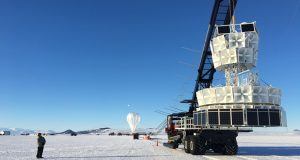Emily Conover in Science News:
 Dangling from a balloon high above Antarctica, a particle detector has spotted something that standard physics is at a loss to explain.
Dangling from a balloon high above Antarctica, a particle detector has spotted something that standard physics is at a loss to explain.
Two unusual signals seen by the detector, known as the Antarctic Impulsive Transient Antenna, or ANITA, can’t be attributed to any known particles, a team of physicists at Penn State reports online September 25 at arXiv.org. The result hints at the possibility of new particles beyond those cataloged in the standard model, the theory that describes the various elementary particles that make up matter.
Like the old man in the Pixar movie Up, ANITA floats on a helium balloon, at an altitude of 37 kilometers for about a month at a time. It searches for the signals of high-energy particles from space, including lightweight, ghostly particles called neutrinos. Those neutrinos can interact within Antarctica’s ice, producing radio waves that are picked up by ANITA’s antennas.
The two puzzling signals appear to be from extremely energetic neutrinos shooting skyward from within the Earth. A neutrino coming up from below isn’t inherently surprising: Low-energy neutrinos interact with matter so weakly that they can zip through the entire planet. But high-energy neutrinos can’t pass through as much material as lower-energy neutrinos can. So although high-energy neutrinos can skim the edges of the planet, they won’t survive a pass straight through.
More here.
